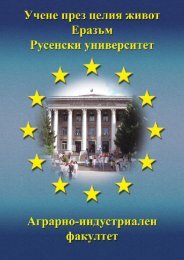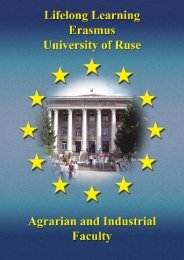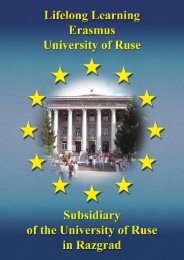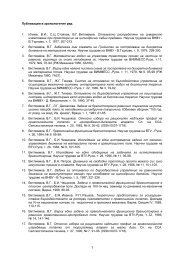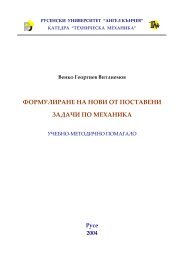Erasmus ECTS Information Package
Erasmus ECTS Information Package
Erasmus ECTS Information Package
Create successful ePaper yourself
Turn your PDF publications into a flip-book with our unique Google optimized e-Paper software.
<strong>Erasmus</strong> <strong>ECTS</strong> <strong>Information</strong> <strong>Package</strong><br />
Faculty of EEEA<br />
426 Semiconductors<br />
<strong>ECTS</strong> credits: 4<br />
Weekly classes: 2lec+0sem+2labs+0ps+0,5p<br />
Assessment: exam<br />
Type of exam: written<br />
Department involved:<br />
Department of Telecommunications, Faculty of Electrical Engineering, Electronics and Automation<br />
Lecturers:<br />
Assoc. Prof. Stoyan Antonov Kazandjiev, MSc, PhD, Dept. of Telecommunications, tel.: 888 381,<br />
E-mail: SKazandjiev@ecs.uni-ruse.bg<br />
Abstract:<br />
The course objective is to familiarize the students with the main active semiconductor devices. The physical<br />
principles are studied as well as the structure, characteristic and parameters of discrete elements. Specific<br />
applications of elements, ways of connection, and methods of operation mode computation are addressed. Brief<br />
information about the technology of manufacturing of discrete elements and integrated circuits is given.<br />
Course content:<br />
Physical fundamentals of semiconductor devises. Semiconductor diodes. Semiconductor stabilitrons. Tunnel<br />
diodes. Bipolar transistors: characteristics; parameters of transistor as a quadripole; frequency properties of<br />
transistors; dynamic and switch mode of transistor operation. Field-effect transistors: junction-gate field-effect<br />
transistors; MOS-transistors. Thyristors. Optoelectronic devices. Fundamentals of microelectronics: types of<br />
integrated circuits; main principles of construction of bipolar and MOS - integrated circuits.<br />
Teaching and assessment:<br />
The lectures give the students the opportunity to familiarize themselves theoretically with the main questions of the<br />
material. Each Iecture is presented using visual materials -slides. The laboratory exercises have a duration of 4<br />
hours every other week and the whole group does the same exercise. Before starting the laboratory exercises the<br />
students` preparation on the theoretical material and methodology of making the measurements is checked. The<br />
students prepare a report for each laboratory exercise which is checked by the lecturer. The results from the<br />
laboratory work are taken into consideration for determining the final mark at the exam. The exam is written with 2<br />
questions from the course syllabus which is followed by an oral discussion.<br />
0427 English Language part 2<br />
ЕCTS credits: 3<br />
Weekly classes: 0lec+0sem+0labs+3ps<br />
Assessment: continuous assessment<br />
Type of exam: written<br />
Department involved:<br />
Department of Foreign Languages, Faculty of Law<br />
Lecturers:<br />
Senior Lecturer Mariela Georgieva Risova, MA, Dept. of Foreign Languages tel.: 888 816,<br />
E-mail: mrisova@ecs.uni-ruse.bg<br />
Senior Lecturer Pencho Konstantinov Kamburov, MA, Dept. of Foreign Languages, tel.: 888 816,<br />
E-mail: pkamburov@ecs.uni-ruse.bg<br />
Senior Lecturer Diana Ilieva Stefanova, MA, Department of Foreign Languages, tel.: 888 230,<br />
E-mail: dstefanova@ecs.uni-ruse.bg<br />
Lecturer Elitsa Dimitrova Georgieva, MA, Department of Foreign Languages, tel.: 888 816,<br />
E-mail: edgeorgieva@ecs.uni-ruse.bg<br />
Abstract:<br />
The foreign language module 2 is also aimed at achieving communicative competence in the area of the subject<br />
specialism and the future job. The teaching objectives comprise the development of reading comprehension skills<br />
to handle specialist texts and the acquisition of communication skills to interact successfully in professional<br />
settings and everyday situations.<br />
Course content:<br />
Higher education. Reading strategies. Note taking. Structure and organisation of a scientific text. Describing a<br />
process. Components and specifications. Describing graphs. Writing a CV. Announcements and messages<br />
(formal and informal). Enquiries, letters of complaint and orders. The grammar material is connected with the<br />
lexical topics and situations.<br />
Teaching and assessment:<br />
To acquire the necessary language proficiency and to develop skills in using the language as a means of<br />
communication a wide range of authentic and specially constructed texts ( i. e. articles, diagrams and tables,<br />
brochures, catalogues, manuals etc.) as well as audio , video, and multimedia materials are used. Students are<br />
offered lessons in computer laboratories, in which multimedia learning packages and on-line materials on the<br />
Internet are used according to the modern trends in foreign language teaching. In class students participate in<br />
role-plays, pair and group activities and they are encouraged to work on their own on their translation assignment.<br />
Continuous assessment involves at least two written tests and oral testing as well.<br />
152



